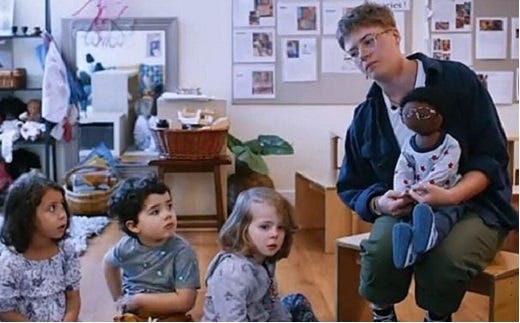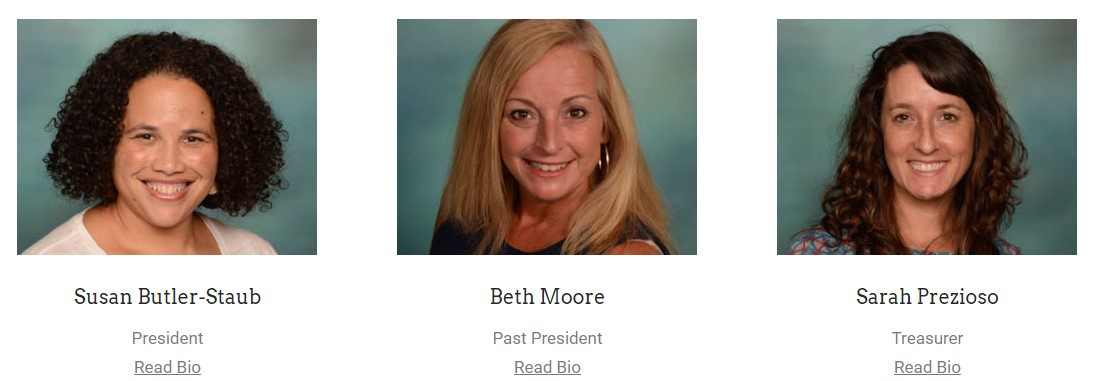Tweet over non-binary documentary shown to NC daycares goes viral
Video clip drawn from documentary on website of North Carolina Association for the Education of Young Children
A tweet by Jordan Chamberlain of the Washington Free Beacon about a teacher “resource” video containing gender ideology that was allegedly shown to North Carolina daycare workers went viral this week:

The full video is on the website of the North Carolina Association for the Education of Young Children (NCAEYC). The documentary’s title is “Reflecting on Anti-bias Education in Action: The Early Years.”
The video includes scenes of teaching children as young as four and five about “gender identity” from their “nonbinary” teacher, Maddie Piper.
Piper uses a nonbinary doll that she tells the kids is named “Nash.”
“A friend likes to ask the question, ‘Are you a boy or a girl?’” said Piper. “Nash answers, ‘I am just a kid.’”
"Nash, just like me, is non-binary," Piper says to the kids. "So they aren't sure if they're a boy or a girl. So when people ask them 'are you a boy or a girl?', right now they just feel like saying: 'I'm a kid'. They're figuring it out."
A child comments, “But kids can be boys or girls.”
Another child speaks up and says, “Or they,” followed by a different child who says, “Yeah, or maybe non-binary.”
In a panel discussion later in the video, another teacher says the kids using the term nonbinary unprompted is "a huge testament to how much we've been talking about it in the classroom.”
It’s worth noting that despite Piper’s instruction, the kids kept calling Nash “he” and were continually corrected. Here’s an example of such an exchange, with emphasis added:
A child asked, “Does he like stars?”
“They like stars,” Piper replied.
The children respond by mimicking the Piper, “They like stars.”
More About the video
“Reflecting on Anti-bias Education in Action: The Early Years” is a 48-minute video created by Debbie LeeKeenan, John Nimmo, and Filiz Efe McKinney.
The video’s own description says it is a series of "vignettes of anti-bias strategies in early childhood classrooms interspersed with teachers reflecting on their practice."
In the acknowledgments for the video, the Tyler Rigg Foundation is cited for a “generous grant” along with “support from Portland State University."
"The film has received numerous awards including the Silver Prize for Documentary Feature (2021) in the Social Justice Film Festival and a nomination for Northwest Regional Emmy® (2022) in the category of diversity, equity, and inclusion – long form content,” the video’s description says.
The video description also states that "Louise Derman-Sparks is the film’s senior advisor."
Derman-Sparks is a well-known Critical Race Theorist whose work is concentrated on Preschool through 3rd grade and whose “antibias education” targets early childhood education with four “core goals” that include Identity, Diversity, Justice, and Activism.
Derman-Sparks’ arguably radical antibias education for young children isn’t just showing up in videos, it’s in professional development in North Carolina K-12 districts. An example is the teacher training led by the Wake County Public Schools’ Office of Equity Affairs cites Derman-Sparks as its inspiration.
There is a "guidebook" for the film that deserves a deeper dive than can be done in a single article.
According to the guidebook, filming began in 2020 and the teachers featured in the video came from the Epiphany Early Learning Preschool, Seattle, Washington State; Southwest Early Learning Bilingual Preschool, Seattle, Washington State; and Pacific Primary School, San Francisco, California.
Additionally, the guidebook notes, “Filming in San Francisco took place during the momentous uprising for racial justice and the Black Lives Matter movement in the summer of 2020 and the continuing spread of the Covid-19 pandemic leading to the wearing of masks in schools. All of the scenes with children were filmed as they happened in the classroom.”
The section of the guidebook dealing with the clip circulated by Chamberlain is as follows:
Persona Doll: Teacher Joyce shares using persona dolls to address fairness; Teacher Maddie introduces a non-binary persona doll to a group of children (17:21-24:14).
There are strategies for both reflecting (mirrors) and extending (windows) awareness and empathy for diversity in your classroom community.
Giving children access to new words can help them to think in more inclusive ways. Non-Binary (transequality.org) is a term used by some people who do not identify as either male or female.
Provocations:
• How might you use persona dolls in your classroom?
• What do you notice about how Teacher Maddie introduces Nash?
• Maddie tells the children Nash is non-binary and is “not sure if they are a boy or girl, so when people ‘ask are you a boy or girl right now,’ they just feel like saying ‘‘I’m a kid, I’m just figuring it out.’”How would you respond to children’s questions or if they don’t accept this response?
The guidebook describes one of the latter "goals" in the movie as "action" that essentially bears out to be the promotion of Black Lives Matter activism:
Spreading the Word: Teachers Nadia and Brian respond to racial injustice, police violence, and protests in their community (35:00-45:57).
Filming in San Francisco took place during the momentous uprising for racial justice and the continuing Black Lives Matter movement in the summer of 2020, and the continuing spread of the Covid-19 pandemic leading to the wearing of masks in schools.
Key Messages:• Teachers take the time to do research and to reach out to community resources about issues to ensure accuracy and depth.
• ABE strategies are most effective when grounded in people, events, and environments that are most meaningful and immediate to the learners.
• Young children are not immune from or necessarily unaware of injustice in society. Find out about and pay attention to their ideas and feelings about local and national events that widely appear in the media and in family conversations. • ABE requires both immediate responses and longer term (planned) strategies.
Provocations:
• How did Nadia and Brian reach out to and include families and other community members in the Black Lives Matter action project? What would you need to do in your setting to ensure this kind of project would successfully happen?
• How do you decide what is appropriate for teachers to bring up and provoke rather than waiting for children to bring it up? (organic vs intentional provocations)
• Discuss differences between the meanings and implications of the concepts “Black Lives Matter” and “All Lives Matter”. Why do you think people choose to support one or the other?
The “action” or activism section has a set of resources that include 6 Reasons “All Lives Matter” Doesn’t Work, BLM principles for Kids, the Black Lives Matter main website, How to Talk to Kids About Racism, Police Violence, and George Floyd’s Death, and a book called “Hands Up!”
There is a set of questions near the end of the guide rationalizing antibias education (ABE) for young children. One question even asks, "Isn’t ABE just teacher propaganda?"
Another asks if ABE is “a fit with standards and required curriculum” or is it an add-on. The answer is ABE is not separate and is “an integrated framework” teachers used in all aspects of their teaching and that the “anti-bias goals are part of social-emotional development, and ABE is crucial to best practices.”
Parents who push back and do not want ABE forced on their children are addressed as well, and in a nutshell, the guidebook basically says “you'll get pushback, but so what? Keep going.”
Part of countering pushback is to "reeducate" the person who objects:
“Provide people with accurate information and education about what your anti-bias education approach is about and its benefits to all children. Correct any misinformation and misconceptions about ABE.”
Websites included at the end of the guide in some aspect all incorporate themes of Critical Race Theory, antiracism, antibias and social justice.
More To The Story
So who or what is NCAEYC?
NCAEYC describes itself as “the state affiliate of the National Association for the Education of Young Children (NAEYC).”
“We are a membership association for anyone who is concerned with the development and education of children ages birth through eight.” the NCAEYC website says. “NCAEYC has over 3,000 members across the state, and NAEYC has nearly 100,000 members across the country.”
NCAEYC goes on to describe its members as “teachers, child care providers, administrators, directors, researchers, college faculty, education coordinators, quality enhancement specialists, and other early childhood professionals.”
Boiled down - It’s a nonprofit that appears to be focused on “equity” and that has a Raleigh, North Carolina address according to the company’s filings with the IRS and the state.
NCAEYC keeps an equity “position statement” hosted on its website which the group boasts is supported by 100 organizations nationwide.
“NCAEYC promotes high-quality early learning for all children, birth through age 8, by connecting practice, policy, and research. We advance a diverse, dynamic early childhood profession and support all who care for, educate, and work on behalf of young children,” reads the NCAEYC mission statement.
The current president of NCAEYC is Susan Butler-Staub. Her bio on the NCAEYC website says she has a decade of experience in North Carolina’s “child care and resource referral field” and is also “an Instructor of Early Childhood Education at Central Piedmont Community College.”
According to IRS filings, NCAEYC claims to have been a 501(c)(3) since January 1973.
The most recent filing by NCAEYC is for Dec. 2019 showing over half a million in gross receipts. A little over $41,000 are marked as "grants" and the rest is "program service revenue." Executive Director Lori Barnes was the only paid employee in the filing with a combined salary of over $80,000.
The NCAEYC website has a donation link that goes to a site called "DonorBox."
DonorBox is described as the "fundraising engine of choice for 50,000 organizations from 96 countries."
From a cursory search, NCAEYC does not appear to have any obvious ties to state government entities such as the N.C. Department of Health and Human Services which oversees daycare and childcare facilities in the state, including Head Start programs.



